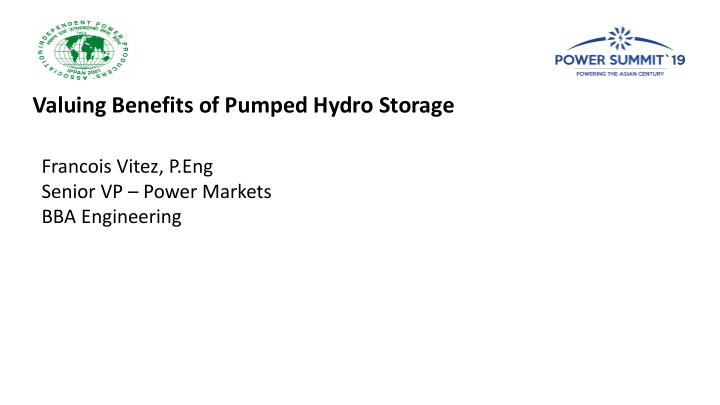



Valuing Benefits of Pumped Hydro Storage Francois Vitez, P.Eng Senior VP – Power Markets BBA Engineering
Through the rear view mirror What are we doing TODAY that will sound absurd to the next generations?
Drivers for Energy Storage Decreasing cost of Solar and Wind generation Decarbonization - Reduction GHG (India 30% of 2005 emissions by 2030) - Retirement of thermal base load - Electrification of the economy
Paradigm Shift in Electricity Supply Yesterday Tomorrow Flexible Source (eg. Hydro, Storage) Source: A Paradigm Shift in Electricity Supply (David Mills/ABC News)
Energy Storage Uses & Categories Behind the meter Distribution Bulk • Microgrids • Local generation capacity • Transmission decongestion • Islanding • Frequency regulation • Peaker replacement • Interconnection expansion deferral • Distribution Substation Investment • Frequency regulation • Time-of-day use Deferral • Energy Arbitrage • Demand-side Management • Distribution Feeder Investment Deferral • Operational reserves • Operational reserves Pumped Storage Chemical Batteries Liquide Air Thermal
Value of Storage Energy storage can enhance the efficiency, cost-effectiveness, and reliability of the electricity grid. It can provide multiple services in one asset and can quickly and economically adapt to changing system needs
Pumped Hydro - Represents 95% of the worlds Electricity Storage (130 GW) - Most were built 40 to 60 years ago along with Nuclear plants
Closed Loop vs Open Loop
Synchronous • Traditional • Longer reaction time (minutes) • Less regulating and flexibility • Cheaper machines • Less submergence (lower cost) • Less benefits to the system
Variable Speed - Faster reaction time (seconds) - Regulating and flexibility - More costly equipment - Deeper submergence (higher costs) - Great value to the system
Ternary Pumped Hydro Units - Turbine & Pump on a same shaft - Torque Converter (Clutch) - Allows for fastest reaction time - Most regulating and flexibility - Pricy equipment - Very large and complex powerhouse ($$$) - Complex Manifull ($$$) - Most benefits to the system
Business Case for PSP Energy Market Ancillary Services (Arbitrage) Operating Reserve Demand Response Load-Shed Service Black Start Service Contingency Reserve Regulating Reserve Arbitrage is great but its Non-Spinning Active Spinning Reserve (Supplemental) Reserve just not enough! Standby Active Active Standby Standby
Business Case for PSP Output Day-Ahead Bid Basic Parameters Schedule of ESS ESS Revenue Round-Trip Optimizer Efficiency Market Parameters Life Cycle Energy Perfect Storage Knowledge Nominal System Energy & Power Market Electricity Forecast Opex & Capex Market Probability of Capacity Dispatch Maintenance Agreement
Typical day operation Arbitrage Only 25 $50 $45 20 $40 15 $35 10 Charge $30 Energy MWh 5 $25 SOC $20 Price 0 1 2 3 4 5 6 7 8 9 10 11 12 13 14 15 16 17 18 19 20 21 22 23 24 $15 -5 $10 -10 $5 -15 $0 *Case study in Alberta, Canada. 10MW/20MWh unit
Typical day operation Revenue Stream Optimizer 20 15 10 MWh 5 0 1 2 3 4 5 6 7 8 9 10 11 12 13 14 15 16 17 18 19 20 21 22 23 24 -5 -10 Charge Energy Act Reg Act Spin Act Sup Stb Reg Stb Spin Stb Sup • *Case study in Alberta, Canada. 10MW/20MWh unit
Annual average revenue $3,000,000 $2,500,000 $2,000,000 $1,500,000 $1,000,000 $500,000 $0 Arbitrage ESS Revenue Optimizer Perfect Knowledge Market Forecast *Case study in Alberta, Canada. 10MW/20MWh unit
धनॎयवाद
Back up slide – ES technology cost comp. Technology Characteristics and market trends Liquid Air $227 $280 Molten Salt $290 $348 Sodium Sulphur $301 $784 Pumped Hydro $152 $198 $561 Lithium-Ion $267 $933 Lead-Acid $425 Flywheel $342 $555 Flow Battery $314 $690 Compressed Air $116 $140 Levelized Cost of Energy ($/kWh) Lazard 2.0, Highview
Australian Pumped Hydro Storage (PSP) Market Australia has identified Pumped hydro Energy Storage as a critical element for supporting its ambitious transition to renewable energy, with >3,000 MW in planned new hydro pumped storage capacity, representing >$5B in total value. AUSTRALIAN PUMPED HYDRO STORAGE MARKET OVERVIEW • 500MW of new pumped hydro projects by 2021, and another 2,300MW by 2030 • PSPs seen as critical element to support Australia’s ambitious renewable energy transition which has already caused 2 major blackouts in the country in recent years; and the renewables portion of the energy mix is set to grow to 50% by 2030! • PSPs critical to manage the “duck curve” caused by Solar & Wind (i.e. low intraday demand/prices which need to be balanced) • Gas prices are very high now in Australia, so pumped hydro energy storage is competitive and Clean. KEY INITIATIVES • $50M Grid Scale Storage Fund by the Government of South Australia and >$25M invested in studies on PHES alone by the Australian Renewable Energy Agency (ARENA) • Recently, NSW Government announced its pumped hydro roadmap: Tasmania’s ‘Battery of the Nation’, and approved the “Snowy 2.0” plan to add 2,000 MW of new renewable pumped hydro capacity to the iconic Snowy Hydro Scheme. • SNC-Lavalin is already involved in several projects and pursuits • Early involvement through Government studies and ECI work for Baroota, Shoalhaven and Kanmantoo • Strong renewable and pumped hydro potential is also spurring new T&D projects such as a second interconnector across the Bass Strait 19 and other interconnection projects to unlock 400 MW of “latent dispatchable capacity” Sources: Australian Renewable Energy Agency (ARENA), Government of South Australia, and Morgan Stanley Strictly Confidential. Not for distribution.
Recommend
More recommend